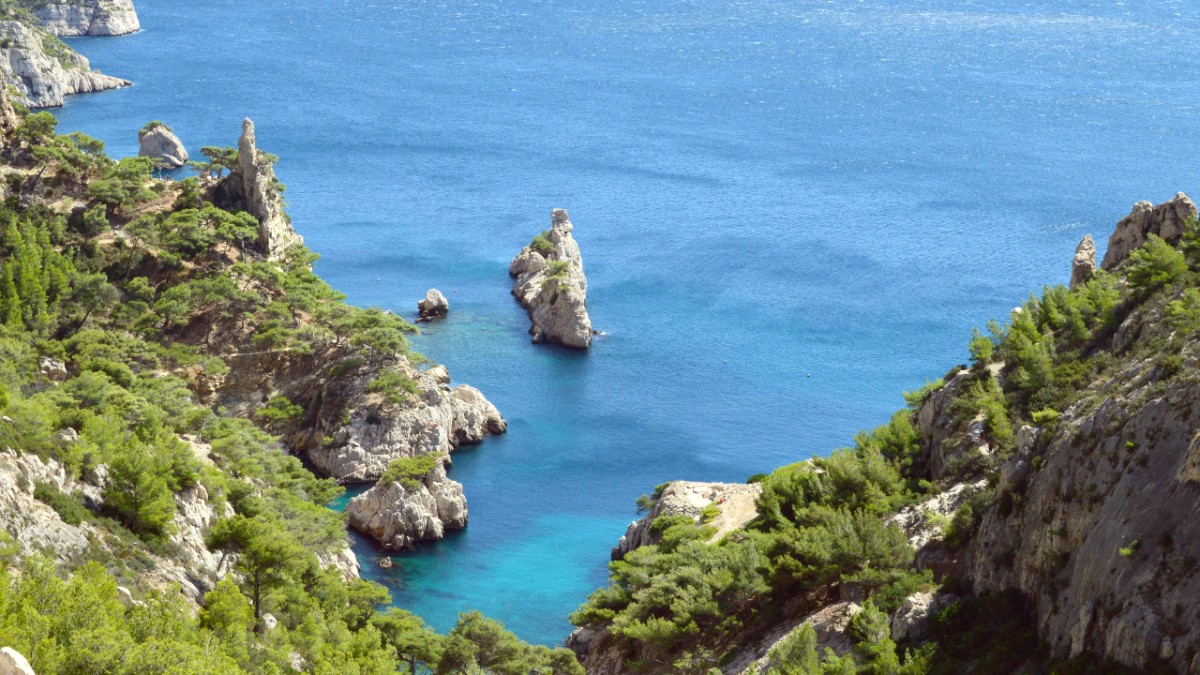
Provence, France
Marseille is positioned in southeastern France, serving as the capital of the Bouches-du-Rhône department and the Provence-Alpes-Côte d'Azur region. Its strategic location on the Mediterranean coast defines much of its character and history. The city developed around a natural harbor, the Vieux-Port, a sheltered inlet that had a secure anchorage for ships for millennia.
The city's landscape includes more than just its coastline. A series of limestone hills and cliffs surrounds Marseille, giving both protection and dramatic scenery. The most prominent of these is the Massif des Calanques, stretching southeast along the coast. These striking natural formations feature deep, narrow inlets (calanques) carved into white cliffs, creating secluded coves with turquoise waters. The Calanques act as a natural barrier, shaping the city's urban sprawl while also giving an accessible natural playground for hiking and water activities.
While not directly at the mouth of the Rhône River in the same way Lyon is, Marseille gains indirectly from the river's influence on the broader Provence region. This blend of coastal access and proximity to fertile lands has given Marseille a diverse resource base throughout its history.
The maritime climate, tempered by the sea, features distinct seasonal patterns that influence visitor experiences. This unique geography gives both urban vibrancy and immediate access to stunning natural landscapes.
Marseille holds the distinction of being the oldest city in France, with a history spanning over 2,600 years. Greek sailors from Phocaea, in what is now Turkey, founded Massalia (the original name of Marseille) around 600 BC. This early establishment immediately positioned the settlement as a trading post in the western Mediterranean. Its deep-water port quickly became a gateway for goods, ideas, and people, connecting the Greek world with the Celtic and Ligurian tribes of inland Gaul.
Throughout antiquity, Massalia prospered as an independent city-state, resisting Roman expansion until its eventual integration into the Roman Empire. Under Roman rule, it retained some autonomy and continued to thrive as a commercial hub. The city's resilience was tested through centuries of invasions, including those by Visigoths, Franks, and Saracens, yet its strategic port secured its eventual recovery and continued importance.
Greek sailors from Phocaea founded Massalia around 600 BC.
Part of Roman Empire, retaining commercial ties.
Survived invasions, re-emerging as a major port.
"La Marseillaise" national anthem has roots here.
Main colonial port, fostering rich diversity.
Its merchants established extensive trading networks across the Mediterranean, bringing wealth and diverse influences to the city. This long history of maritime trade instilled in Marseille an unique multicultural identity, distinct from other French cities. Its population had always been a blend of peoples from various Mediterranean shores, creating a rich cultural mosaic.
The French Revolution found a passionate echo in Marseille, giving the city its enduring association with the national anthem, "La Marseillaise," which revolutionary troops from Marseille sang on their march to Paris. In the 19th and 20th centuries, Marseille continued its role as France's main colonial port, specifically for trade with North Africa, further cementing its diverse character. The city faced destruction during World War II but rebuilt with determination, preserving its historical heart while adapting to modern challenges. This layered history makes Marseille a place where every street corner and every neighborhood tells a story of survival, trade, and cultural fusion.
Population: Approximately 873,076 (2020). Area: 240.62 km² (92.9 sq mi). Language: French. Currency: Euro (€). Time Zone: CET/CEST.
Industries: Maritime trade, logistics, tourism, aerospace, petrochemicals. Noteworthy Features: Europe's oldest city, major port, gateway to Provence, dramatic calanques.
These details frame your visit, aiding your grasp of the city's scale, language, and economic heartbeat.
Marseille, France's second-largest city by population, features a bustling urban environment with lively streets and a dynamic pace. Its size means you find a wide array of services, dining options, and attractions.
The city spans a considerable area, encompassing both a dense urban core and sprawling suburbs that extend into the surrounding hills and coastline. This large size means that while central areas are walkable, you often need public transport or other means to explore its diverse neighborhoods and natural attractions like the Calanques.
Approximately 873,076 people (2020 data), making it France's second-largest city.
French is the main language. Euro (€) is the currency.
Central European Time (CET/CEST). Industries include maritime trade, tourism, and aerospace.
Marseille boasts several distinctions that define its character and appeal.
Marseille presents a raw, energetic, and authentic French experience. Its spirit and rich history make for a memorable visit.